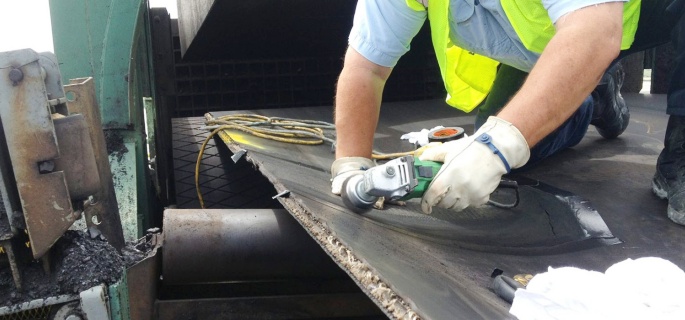How to Cut Conveyor Belt: Tools and Safety Tips
In the world of industrial maintenance and fabrication, knowing how to cut conveyor belt material effectively is a valuable skill. This process is not only about making the belt fit your specific needs but also ensuring the longevity and functionality of the conveyor system itself. Whether it’s for custom installations that require specific lengths or for repairs that need removing damaged sections, the task demands precision and understanding. In this blog post, we delve into the multitude of methods and tools designed for this purpose, emphasizing the challenge posed by steel-reinforced and thick conveyor belts. Our goal is to guide you through the techniques that will help you achieve clean and accurate cuts, thereby optimizing your conveyor belt’s performance and safety. With a focus on both traditional and modern cutting tools, we aim to equip you with the knowledge necessary for this essential aspect of conveyor belt maintenance and customization.
Tools and Methods About How to Cut Conveyor Belt
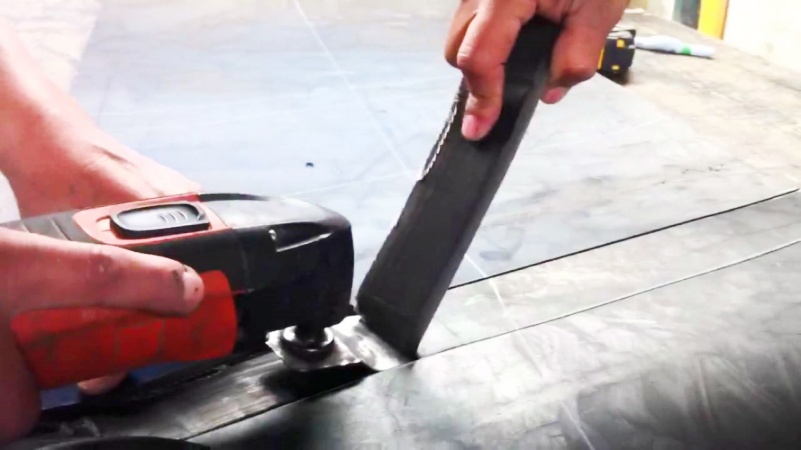
Cutting conveyor belts accurately and safely is a critical task in various industrial settings. The methods and tools for how to cut conveyor belt materials can vary significantly based on the belt’s composition, thickness, and the precision required for the job. In this comprehensive guide, we explore the array of tools and techniques at your disposal. And learn to cut conveyor belts using jigsaw blades, pressure techniques, and the centerline method for precise, efficient cuts.
By Hand
Overview: Traditional methods of cutting conveyor belts by hand involve using basic tools like scissors, shears, or knives. This approach requires meticulous attention to detail to maintain straightness and avoid damage to the belt edges. Safety is paramount, as manual cutting can pose risks of injury without proper precautions.
Best Practices:
- Use a straight edge or ruler to guide your cuts and ensure they are linear.
- Select a sharp utility knife that can easily penetrate the belt material without excessive force.
- Mark your cutting line with chalk or a marker for visibility and accuracy.
- Wear cut-resistant gloves to protect your hands during the cutting process.
- Maintain a steady hand and apply even pressure to avoid jagged edges.
Utility Knives and Handheld Tools
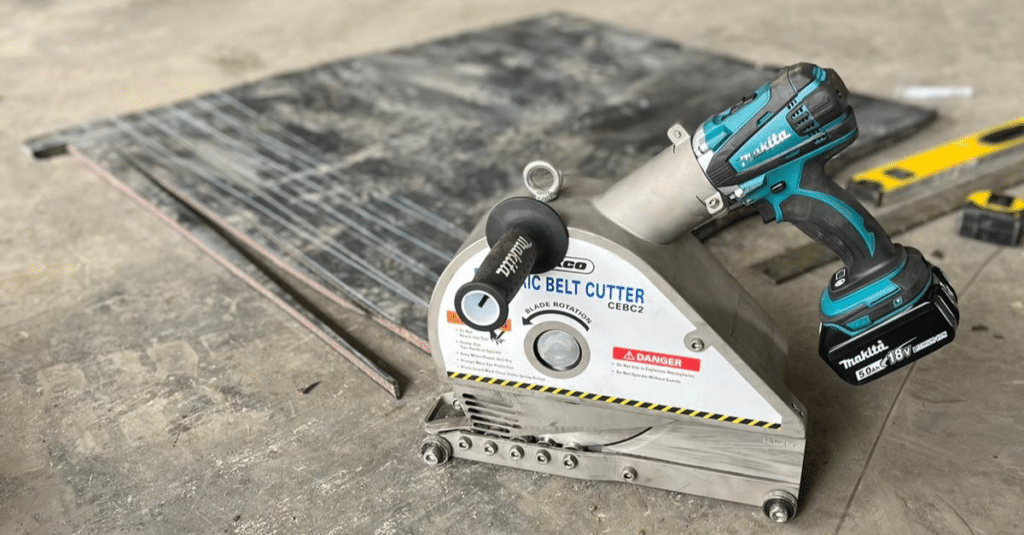
Utility Knives: A staple in cutting conveyor belts, utility knives offer simplicity and precision. However, users must be wary of the physical effort required, particularly with thicker materials, and the potential for accidents if safety practices are not followed.
Oscillating Tools: For those looking for a more refined cut, oscillating tools provide exceptional control and accuracy. They are particularly useful for:
- Making intricate cuts or shapes in conveyor belts.
- Cutting through reinforced areas with ease.
- Reducing physical strain compared to manual cutting.
- Minimizing dust and debris.
- Offering quick blade changes for different materials.
Power Tools
Angle Grinder
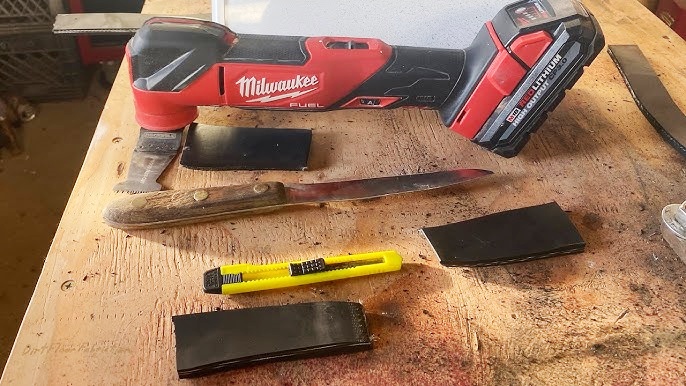
Using an Angle Grinder: Angle grinders, equipped with the right disc, can swiftly cut through conveyor belt material. Key considerations include:
- Choosing a disc suited for the belt’s material to prevent tearing.
- Wearing protective gear to guard against sparks and debris.
- Securing the belt firmly to prevent slippage during cutting.
- Starting with a shallow cut to guide subsequent passes.
- Keeping the grinder at a consistent angle for even cutting.
Circular Saw
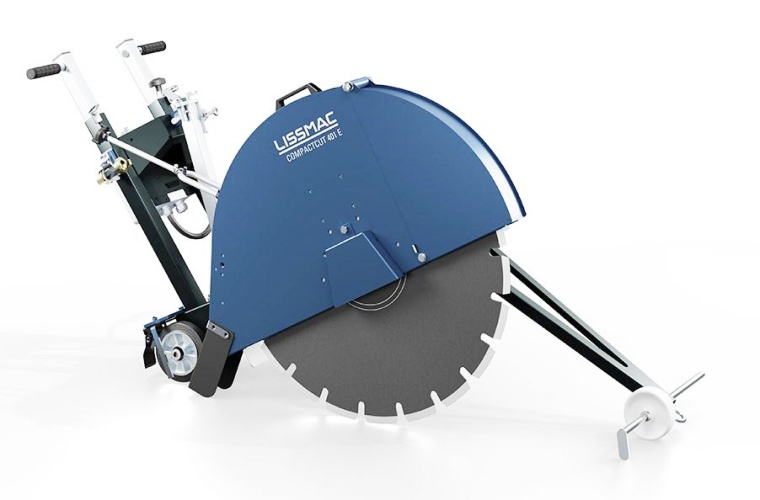
Cutting with a Circular Saw: A circular saw can provide clean, straight cuts across a conveyor belt. It’s crucial to:
- Use a blade designed for the material of the conveyor belt.
- Set the correct blade depth to match the belt’s thickness.
- Apply steady, forward motion to avoid blade binding.
- Keep hands and loose clothing clear of the saw’s path.
- Follow all safety instructions for the saw’s operation.
Industrial Cutting Tools

Conveyor Belt Cutting Tool: Specialized industrial tools like the Flexco belt cutter are engineered for cutting conveyor belts, offering advantages like:
- Precision cutting with minimal effort.
- Built-in safety features to protect the operator.
- Capability to cut through thick and reinforced belts.
- Enhanced durability for frequent use.
- Easy to replace blade cartridges.
Best Tool to Cut Conveyor Belt: The selection of the best tool depends on factors like belt material, thickness, and the specific requirements of the cut. Evaluations and comparisons of different tools can be presented in tables to highlight their suitability, ease of use, safety features, and overall efficiency.
Special Considerations
Steel Reinforced Conveyor Belts
Challenges and Solutions: Cutting through steel-reinforced conveyor belts presents unique challenges. The key is to choose tools that can slice through the metal without damaging the belt. Techniques and tools that excel in this regard include:
- High-speed rotary tools with metal-cutting discs.
- Abrasive cutoff wheels designed for metal.
- Plasma cutters for thick and heavily reinforced belts.
- Hydraulic shears for precise, low-effort cutting.
- Waterjet cutting for the highest precision and material preservation.
Cutting Thick Conveyor Belts
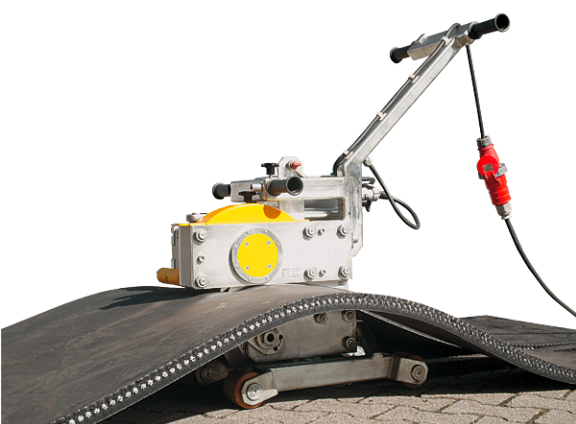
Approach: Extra-thick conveyor belts require tools with sufficient power and the right cutting technique. Strategies include:
- Pre-marking the cut line clearly across the belt’s surface.
- Choosing saws or cutters with deep penetration capabilities.
- Applying slow, steady pressure to ensure a clean cut.
- Utilizing guides or jigs to maintain straightness.
- Ensuring the cutting tool is adequately cooled to prevent overheating and damage to the belt material.
Cutting conveyor belts straight is a meticulous process that requires attention to detail and precision. Whether you’re resizing a belt for a custom installation or removing a damaged section for repair, the ability to cut straight is fundamental. In this section, we detail the crucial steps and best practices on how to cut a conveyor belt material straight, ensuring optimal performance and longevity of the belt.
Safety Concerns When Using Knives for Cutting Conveyor Belts
Risks Associated with Using Stanley Knives and Similar Tools
Cutting conveyor belts with Stanley knives and other similar tools poses several risks due to the nature of the material and the tool itself. Conveyor belts are often made from tough, durable materials designed to withstand heavy loads and harsh conditions, making them challenging to cut with handheld knives. The risks associated with using these tools include:
- Slipping of the Knife: The tough material of conveyor belts requires significant force to cut through, increasing the likelihood of the knife slipping. A slip can result in severe cuts and injuries to the operator or others nearby.
- Inadequate Control: Handling a Stanley knife or similar tool while applying considerable force can lead to loss of control, especially if the knife is not ergonomically designed for such tasks. This loss of control can result in accidental stabbings or deep lacerations.
- Excessive Force: The need to apply excessive force increases the risk of muscle strain and fatigue, leading to potential accidents caused by reduced concentration or physical capability.
- Improper Handling: Conveyor belts often need to be cut in awkward positions or confined spaces, making it difficult to maintain a safe and controlled cutting environment. Improper handling in such conditions can increase the risk of injury.
- Tool Condition: Using dull or damaged blades can exacerbate the above risks as they require even more force to cut through the belt, increasing the chances of slipping and accidents.

Common Injuries and Incidents
Numerous injuries and incidents have been reported involving the use of Stanley knives and similar tools for cutting conveyor belts. These incidents highlight the potential dangers and reinforce the need for safer alternatives and practices:
- Deep Lacerations: Operators often sustain deep cuts on their hands, arms, or legs due to the knife slipping or loss of control during the cutting process.
- Puncture Wounds: Accidental puncture wounds can occur if the knife slips or the operator loses control, leading to the blade penetrating deeply into the skin.
- Muscle Strain and Fatigue: Prolonged use of handheld knives for cutting tough materials can lead to muscle strain, fatigue, and repetitive strain injuries (RSIs), reducing the operator’s ability to perform tasks safely.
- Accidental Stabbings: In confined or awkward spaces, the risk of accidentally stabbing oneself or others increases significantly.
- Tool Malfunction: Using dull or damaged knives can lead to tool malfunction, increasing the risk of accidents and injuries.
Importance of Using Appropriate Tools and Techniques
To mitigate the risks associated with using Stanley knives and similar tools, it is crucial to use the appropriate tools and techniques for cutting conveyor belts. This approach not only enhances safety but also improves efficiency and precision:
- Mechanical Belt-Cutting Tools: These tools are specifically designed for cutting conveyor belts and provide a safer and more efficient alternative to handheld knives. They often feature clamping mechanisms that hold the belt securely in place, reducing the risk of slipping and ensuring a straight, precise cut.
- Electric Belt Cutters: These devices use rotating blades to cut through the belt with minimal effort and risk. Electric belt cutters are particularly useful for thick or reinforced belts, where manual cutting would be too labor-intensive and dangerous.
- Slitting Machines: For businesses that frequently cut conveyor belts, investing in a slitting machine can be a cost-effective and safe solution. These machines provide precise, clean cuts with minimal risk to the operator.
- Proper Training: Ensuring that all operators are adequately trained in the use of cutting tools and safety procedures is essential. Training should cover the correct handling of tools, the importance of maintaining sharp and undamaged blades, and safe cutting techniques.
- Personal Protective Equipment (PPE): Operators should always wear appropriate PPE, including cut-resistant gloves, aprons, and goggles, to protect themselves from potential injuries. Regular inspection and replacement of PPE are necessary to ensure maximum protection.
By prioritizing safety and using the right tools and techniques, the risks associated with cutting conveyor belts can be significantly reduced, leading to a safer working environment and more efficient operations.
Measurement and Marking for How to Cut Conveyor Belt
The first step in ensuring a straight cut is accurate measurement and marking. This cannot be overstated, as it lays the groundwork for the entire cutting process. Begin by determining the exact length and width where the cut is to be made. Use a flexible measuring tape for accuracy, especially on larger belts. Once the measurements are taken, mark the cut line clearly on the belt’s surface. It’s recommended to use a chalk line or a non-permanent marker for visibility. A straightedge or a long level can help in drawing a perfectly straight line across the belt, serving as your guide during the cutting process.
Tool Selection
Choosing the right tool is critical for making straight cuts on a conveyor belt. The selection depends largely on the belt’s material and thickness. For thinner, non-reinforced belts, a sharp utility knife or a pair of heavy-duty scissors might suffice. However, for thicker or steel-reinforced belts, more robust tools like a circular saw or an angle grinder equipped with a suitable cutting blade are necessary. Oscillating tools can also be effective for precise cuts, especially in tight spaces or for detailed work. Ensure that the chosen tool is comfortable to handle and is equipped with safety features to protect against accidents.
Cutting Process
With the cutting line marked and the appropriate tool selected, you’re ready to proceed with the cutting process. Here’s a step-by-step guide to achieve a clean, straight cut:
- Secure the Belt: Ensure the conveyor belt is securely fixed in place to prevent it from moving or slipping during the cutting process. Use clamps or a vise on a stable surface if necessary.
- Safety First: Wear appropriate safety gear, including gloves and eye protection, to safeguard against potential hazards.
- Begin the Cut: Position the tool at the beginning of the marked line. If using a saw or grinder, start the tool before making contact with the belt to achieve a smooth entry. For manual cutting with a knife, apply steady pressure and use the straightedge as a guide to keep the blade aligned.
- Follow Through: Maintain a steady hand and focus on following the marked line closely. For power tools, let the tool do the work without forcing it through the material. Overexertion can cause the tool to veer off course or damage the belt.
- Check the Cut: Once the cut is complete, inspect it for straightness and any fraying edges. If necessary, use a file or sandpaper to smooth out any rough sections along the cut edge.
By adhering to these steps and maintaining a focus on precision and safety, you can achieve straight, clean cuts on conveyor belts, ensuring they fit perfectly for your specific application. Remember, practice and patience are key to mastering how to cut conveyor belt materials accurately.
When undertaking the task of how to cut conveyor belt materials, prioritizing safety is paramount. Cutting conveyor belts, especially those that are thick or reinforced, involves sharp tools and machinery that pose significant risks. To mitigate these hazards, it’s crucial to adhere to strict safety measures and use the appropriate protective gear. Here, we outline the essential safety equipment and precautions necessary to ensure a safe working environment during the cutting process.
Get customized conveyor belt solutions – reach out now!
Safety Measures for How to Cut Conveyor Belt
Protective Eyewear: The use of sharp tools and power equipment can generate flying debris and dust, posing a serious risk to your eyes. Always wear ANSI-approved safety glasses or face shields to protect against particles and sparks.
Cut-Resistant Gloves: Protecting your hands is just as important, particularly when handling sharp edges or operating cutting tools. Use gloves made from cut-resistant materials to prevent cuts and abrasions. Ensure the gloves provide a good grip to safely handle tools and materials.
Hearing Protection: Power tools, such as angle grinders and circular saws, can produce high noise levels that are harmful over time. Wearing earplugs or earmuffs will help protect your hearing during prolonged exposure to these sounds.
Respiratory Protection: Cutting some types of conveyor belt materials can release harmful particles into the air. When working in poorly ventilated areas or cutting materials known to produce hazardous dust, wear a dust mask or a respirator to prevent inhalation of these particles.
Proper Handling Techniques: Understanding how to handle the tools and materials safely is fundamental. Always ensure that the conveyor belt is securely fixed before cutting to prevent slippage. Use clamps or a vice to hold the belt in place on a stable surface, reducing the risk of an accident.
Tool Safety: Familiarize yourself with the operation and safety features of any tool before use. Check that all tools and equipment are in good working condition, and always follow the manufacturer’s instructions. For power tools, ensure you have a clear understanding of how to operate them safely, including how to engage and release the power safely.
Work Area Safety: Keep your work area clean and organized. Remove any unnecessary items and ensure all safety equipment is within easy reach. A well-maintained work environment reduces the risk of trips, falls, and other accidents.
First Aid: Always have a first aid kit readily available in your work area. In case of an accident, quick access to bandages, antiseptics, and other basic first aid supplies can provide immediate care before professional medical help is sought.
By incorporating these safety measures into your routine when learning how to cut conveyor belt materials, you can minimize the risk of injury and create a safer work environment. Remember, the key to safe operation is preparation, awareness, and the correct use of safety equipment and techniques.
FAQs About How to Cut Conveyor Belt
Cutting a steel cord conveyor belt requires precision and the right tools to ensure the integrity of the belt is maintained while achieving a clean cut. Start by accurately measuring the area to be cut. Mark the cutting line clearly on the belt. For steel cord belts, a high-powered angle grinder with a metal cutting disc is commonly used, as it can slice through the tough steel cords efficiently. Safety gear, including gloves, eyewear, and ear protection, is essential due to the risk of flying sparks and metal fragments. To cut, secure the belt and gently guide the grinder along the marked line. Maintain a steady pace to avoid overheating any area. After cutting, it’s important to file down any sharp edges to prevent injury or damage to the belt. This task demands a high level of care and precision, given the complexity of cutting through steel-reinforced material.
Measuring and cutting a conveyor belt accurately is vital for the belt’s proper installation and operation. Begin by determining the length of belt you need, considering any specific installation requirements. Use a flexible measuring tape to measure the belt length accurately. Mark your cutting line with a chalk line or marker, ensuring it’s perfectly straight by using a ruler or a straight edge. Depending on the belt material, a sharp utility knife (for softer, non-reinforced belts) or a power saw (for thicker, reinforced belts) may be used for cutting. When cutting, secure the belt to prevent movement, and always wear appropriate safety gear, such as gloves and eye protection. Make your cut along the marked line, taking care to ensure it remains straight and clean. For thicker belts, several passes with the cutting tool may be necessary.
Conveyor belt splicing is the process of joining two pieces of a conveyor belt together, ensuring the belt functions correctly and efficiently. The two primary splicing techniques are mechanical splicing and vulcanization.
Mechanical Splicing involves using metal hinges or plates to join the belt ends. This method is quick and can be performed in the field but may not be as durable as vulcanization, especially in heavy-duty applications.
Vulcanization, or hot/cold splicing, uses heat and pressure (for hot splicing) or adhesives (for cold splicing) to bond the belt ends together. Vulcanized splices are nearly seamless and provide a very high level of strength and flexibility, making them ideal for high-stress applications. The choice between these techniques depends on the specific requirements of the conveyor system, including the belt material, operational loads, and environmental conditions.
Stopping a conveyor belt safely is crucial to prevent damage to the belt, the conveyed materials, and the conveyor system itself. Most conveyor systems are equipped with a stop button or switch that can be activated in an emergency or for routine maintenance. It’s essential to familiarize yourself with the conveyor’s control system and know the location of these emergency stop buttons. In addition to manual stopping, conveyors often have automatic sensors that can trigger a shutdown in case of an overload or a system malfunction, further protecting the system and its operators. Regular maintenance and inspection of the conveyor and its safety features are critical to ensuring that it can be stopped quickly and safely when needed.
Gather Your Tools: You’ll need a measuring tape, a straight edge or square rule, chalk or a marker, and a sharp cutting tool such as a utility knife or a jigsaw with a suitable blade.
Mark the Centerline: Measure the width of the belt and find its center. Use a piece of chalk or a marker to draw a straight line along the center of the belt.
Align the Straight Edge: Place the straight edge or square rule perpendicular to the belt along the centerline mark. Ensure it is perfectly square to the edges of the belt.
Mark the Cutting Line: Use the straight edge as a guide to draw a straight line across the belt. This will be your cutting line.
Cut the Belt: Carefully cut along the marked line using your cutting tool. Apply even pressure to ensure a clean, straight cut. For thicker belts, you may need to make several passes with the knife or use a jigsaw for a smoother finish.
Check the Cut: After cutting, verify that the cut is square by measuring diagonals from the corners of the cut section. Both measurements should be equal if the cut is square.
Safety First: Ensure the conveyor is powered off and properly secured to prevent any accidental movement.
Determine the New Length: Measure and mark the desired new length of the conveyor belt.
Mark the Cutting Line: Use a straight edge or chalk line to mark where the cut will be made. Ensure the line is straight and perpendicular to the belt’s edges.
Cut the Belt: Using a utility knife or jigsaw, cut the belt along the marked line. For best results, follow the steps mentioned above for cutting a belt square.
Remove the Excess Belt: Carefully remove the excess belt material.
Reattach the Belt Ends: If your conveyor belt uses mechanical fasteners, reattach the belt ends using the appropriate fasteners. Ensure they are securely fastened and properly aligned. For belts with splices, you may need to follow specific procedures for re-splicing the belt, such as using a vulcanizing press.
Test the Belt: Once the belt is shortened and reattached, run the conveyor at a slow speed to check for proper alignment and tension. Make any necessary adjustments to ensure smooth operation.
Final Adjustments: Adjust the conveyor’s tension and tracking mechanisms as needed to ensure the belt runs smoothly and stays aligned during operation.
Last Updated on June 21, 2024 by Jordan Smith
Jordan Smith, a seasoned professional with over 20 years of experience in the conveyor system industry. Jordan’s expertise lies in providing comprehensive solutions for conveyor rollers, belts, and accessories, catering to a wide range of industrial needs. From initial design and configuration to installation and meticulous troubleshooting, Jordan is adept at handling all aspects of conveyor system management. Whether you’re looking to upgrade your production line with efficient conveyor belts, require custom conveyor rollers for specific operations, or need expert advice on selecting the right conveyor accessories for your facility, Jordan is your reliable consultant. For any inquiries or assistance with conveyor system optimization, Jordan is available to share his wealth of knowledge and experience. Feel free to reach out at any time for professional guidance on all matters related to conveyor rollers, belts, and accessories.

